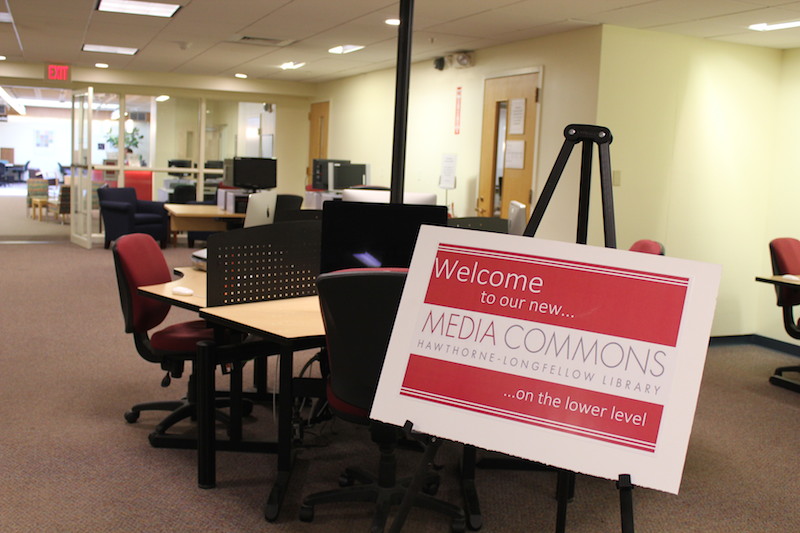Library Opens Media Commons to Enhance Cinema Studies

The lower level of the Hawthorne-Longfellow Library is now home to the College’s Media Commons, a new space designed for studying films and producing video, animation, photography and audio projects.
In addition to a suite of computers equipped with diverse media-making software, the Media Commons has two screening rooms — a larger room for seminars and a smaller room for groups of four or five. It also offers a video recording studio with a green screen, and an editing studio with a whisper room for producing audio tracks.
The Media Commons reflects Bowdoin’s efforts to centralize and enhance its media services, and to better support cinema studies classes and student video production. Its opening coincides with a recent push by Bowdoin to strengthen its Cinema Studies program.
For many years, Professor Tricia Welsch was the only faculty member appointed in Film Studies. Welsch was joined in 2010 by Visiting Assistant Professor Sarah Childress, an expert in areas that include Latin American and avant-garde film. In addition, three other faculty now have joint appointments with the Cinema Studies program: Professor Aviva Briefel (English and cinema studies); Professor Shu-chin Tsui (Asian studies and cinema studies); and Assistant Professor Alison Cooper (Romance languages and cinema studies). Last year, Cinema Studies also revised its five course requirements for minors to ensure that students graduated with knowledge about film technique, theory and history, and international cinema.
The Media Commons incorporates the collections and services of the college’s former Language Media Center, which was originally created to help students with second language acquisition. Over time, the center evolved to handle video projects, but wasn’t well suited for this service. What was needed instead, according to Bowdoin Library Director Marjorie Hassen, was a consolidated, updated area for teaching film and for media production. “There is more happening on campus with film,” Hassen said. “More faculty and students are engaged with it. This space creates a hub to support all that activity.”
The Library and the Academic Technology & Consulting group collaborated on the planning of the Media Commons, and worked with Cinema Studies faculty to ensure the space would meet professors’ pedagogical needs. Briefel said that the Media Commons enables students to watch films “under the best possible conditions,” with “fantastic” image and sound quality. “It’s better than watching videos in the dorm or in the library on a small screen,” she said. “It facilitates our job [as cinema studies faculty] and brings students closer to a cinematic experience of watching films.”
The space now houses the bulk of the library’s films available for check-out and includes individual stations for viewing analog, digital and streaming media. Soon the Commons will have filmmaking equipment — cameras, lights, microphones, etc. — available for students to borrow. When the large screening room with its 85-inch, hi-def flat screen is not being used for teaching or course-related film screenings, it can be booked by students.
Library and Academic Technology & Consulting staff also plan to offer weekly workshops that focus on different aspects of film and audio production. Student tech consultants will soon be available to assist their peers with projects.
“We’d like to make this an active, vibrant space,” Hassen said.
Learn more about the Media Commons here.







